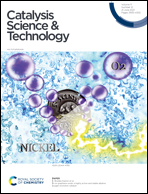Syntheses, design strategies, and photocatalytic charge dynamics of metal–organic frameworks (MOFs): a catalyzed photo-degradation approach towards organic dyes
Abstract
Metal–organic frameworks (MOFs) or coordination polymers (CPs) are regarded as new variety of materials that find potential applications in several areas such as gas/small molecule absorption/separation, gas storage, membranes, and drug delivery system. Also, MOF-incorporating nanoparticles display activity towards various catalytic/electrocatalytic/photocatalytic processes. However, the application of pure metal–organic frameworks as photocatalysts has been recently explored. Further, computational studies on MOFs/CPs add newer insight to better understand the mechanistic pathways through which this new class of materials displays photocatalytic properties. The presented perspective emphasizes the general introduction of syntheses, design strategies and structures of photoactive metal–organic frameworks, and the plausible mechanistic pathways through which these MOFs display photocatalytic degradation of organic molecules in particular organic dyes that are usually present in wastewater discharge from industries.



 Please wait while we load your content...
Please wait while we load your content...